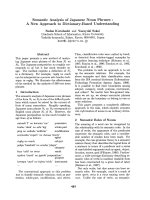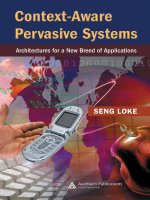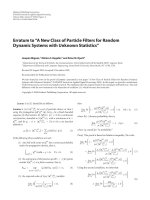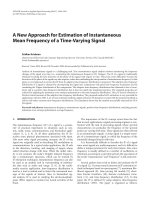A new approach of developing compliance checking system
Bạn đang xem bản rút gọn của tài liệu. Xem và tải ngay bản đầy đủ của tài liệu tại đây (933.84 KB, 70 trang )
I
A New Approach of Developing Compliance-Checking
System
Xu Rong
SCHOOL OF COMPUTING
NATIONAL UNIVERSITY OF SINGAPORE
II
2004
Abstract
Automate the process of building plan approval becomes a more and more urgent
issue to current building industries. Existent code-compliance checking systems use the
CAD data directly. While the CAD data can provide some low-level information, a lot of
high-level semantic information required for code-compliance checking is not available
directly. This thesis introduces a new approach of code-compliance checking. The major
idea is to apply a pre-computation procedure to derive the semantic information from
CAD data. The derived semantic information will be stored in a new building model
called building checking object model, which will be used by code-compliance checking.
In this way, the new approach of code-compliance checking provide a more effective and
efficient solution. The checking request can be submitted by Internet and results will be
visualized in 3D together with the 3D CAD models.
Keywords: STEP, Industry Foundation Classes, Code Compliance Checking, Code
Checking Object Model, Computer Aided Architecture Engineering, 3D Modeling
III
ACKNOWLEDGEMENTS
First of all, I would like to thank Dr. Huang Zhiyong who provided me invaluable advice
and guidance throughout the course of writing this thesis.
I would also like to thank my family who understood me and supported my graduate
studies.
Lastly, I would like to thank the school, which provided the opportunity and resources to
make my thesis possible.
I
V
Table of Contents
1. Introduction 1
1.1. Background 1
1.2. Objective 4
1.3. Paper outline 6
2. Related work 7
2.1. IFC 7
2.2. BP-Expert 11
2.3. Solibri Model Checker 12
2.4. Han’s code compliance checking system 13
2.5. 3D data structures 14
3. System overview 16
4. CCOM module 20
4.1. CCOM module overview 20
4.2. Motivation of CCOM 20
4.3. Definition of CCOM 22
4.4. CCOM data construction 26
5. Algorithm analysis 38
5.1. Single-source shortest path algorithm 38
6. Checking module on top of CCOM 41
7. Application module 45
8. Implementation and results 47
V
9. Conclusion 52
10. Summary 54
11. Reference 55
Appendixes:
Sample of codes and regulations with interpretation
1
1. Introduction
1.1. Background
Computer graphics have been successfully applied in architecture design.
For example, geometric modeling and visualization provided alternatives for
architects to model and evaluate 3D structures in ways more flexible than the
traditional method of making a real scaled down model. There are more demands
to extend visualization application into new areas. One of these new areas that we
address in the thesis is the code-compliance checking of architectural plans.
Currently, building industries face more and more complicated regulations
and codes of practice [7, 8] like other engineering industries. Every year,
governments of countries spend huge amounts of manpower in validating building
plans manually. The complexity and the changing nature of codes lead to delays
in both the design and construction process. The designer must assess which
codes are applicable to a given project as well as sort through potential ambiguity
in the code provisions. The inspectors also must go through a similar process
when doing approval. In addition, different inspectors may have different
interpretations on a given section of codes. This inconsistency makes the approval
process more difficult to be processed. Automating this process will speed up the
building plan approval process and give both designer and permit-issue
department a consistent framework to apply and check codes.
2
Recently, researches have been conduced to seek the automatic method for
code compliance checking [1, 2, 5, 6]. Almost all of the research works are using
Industry Foundation Classes (IFC) [4], a standard defined by International
Alliance for Interoperability (IAI), as the basis for representing the building
model information. In October 1997, the first building compliance checking
system called BP Expert [10] was launched in Singapore. This system reads CAD
data directly and checks them against those pre-loaded rules. Also in 1997, a
client/server framework for online building code compliance checking is
proposed by Charles S Han [1]. Within this framework, data from CAD system
are extracted as IFC EXPRESS file and read by the code-checking server to
produce checking results. The code-checking server is implemented in Java and
all classes are strictly following the semantics of IFC semantics. In June 2001, the
first commercial building compliance checking product called Solibri Model
Checker (SMC) was announced at AEC (Architecture Engineering Construction)
System Show in Chicago. SMC imports IFC R1.5.1 and IFC R2.0 product model
files as its input data and do checking on the model.
While IFC is sufficient to achieve the interoperability of building
information, its data nature is insufficient to support the code compliance
checking. There is no provision in IFC to capture higher-level semantics of
building elements while a lot of code-compliance checking requires high-level
semantics of elements. As a result, most of the research works can only handle
some simple checking, such as checking the fire rating of a wall. Neither BP
3
Expert nor SMC can handle complex checking such as calculate the travel
distance from a space to a nearest exit staircase. The limitation of IFC prevents
them from handling more complex checking.
4
1.2. Objective
Unlike other research works, this paper presents a better approach of
developing code compliance checking system. To increase the capability of the
system so that it will be able to handle more code compliance checking, a new
object model called Code Checking Object Model (CCOM) is introduced. CCOM
is actually a platform built up based on IFC object model and extended. CCOM
object contains not only the low-level information that is already contained in IFC
object model, but also contains high-level semantics such as object relationships,
system networks and common checking logics, which cannot be found in IFC
object model. While IFC model is still a building design model, CCOM becomes
a building-checking model, which is more suitable to be used by code-compliance
checking systems.
By using CCOM, new checking rules can be added into the code
compliance checking system very easily because all the required high-level
semantics is contained in CCOM object already. The consistency of basic
checking logic will also be increased, as the common checking logics are included
in CCOM, too. At the same time, some information in IFC that is useless for
code-compliance checking will not be included in CCOM. Furthermore, by
classifying the codes and regulations from different countries [5], compliance
checking application can be customized to different code checking requirements
of different countries [7, 8] by using CCOM.
5
Thus, the objective of this paper is to present a better approach of
developing code-compliance checking system so that the system can be more
compatible and consistent.
6
1.3. Paper outline
Chapter 2 briefly reviews the existing work in the area of code compliance
checking.
Chapter 3 gives an overview of the code compliance checking system.
Chapter 4 describes the details of CCOM.
Chapter 5 analysis the algorithms used in CCOM.
Chapter 6 shows how checking is done based on checking rules and
CCOM objects.
Chapter 7 introduces the web application module of the code compliance
checking system.
Chapter 8 shows the implementation and testing results.
Chapter 9 gives the conclusion and lists the shortcoming of this system
and possible improvement can be made in the future.
7
2. Related work
This chapter introduces some related works of code compliance checking
system. We first introduce the Industry Foundation Classes (IFC), a widely used
standard object model of building elements in CAD related software. Many code-
compliance checking systems use IFC data as their inputs. Some important code-
compliance checking systems include the BP-Expert developed in Singapore in
1997 [10], the client/server framework for online building code checking done by
Charles S. Han [1] and the Solibri Model Checker (SMC) done by Solibri, Inc
[11].
2.1. IFC (Industry Foundation Classes)
The idea of creating an integrated data model for achieving data sharing
between multiple AEC software applications has been proposed by many
researchers. For example, M. Sun’s paper described an architectural CAD
prototype originated from the Computer Models for the Building Industry in
Europe (COMBINE) project [16]. However, only IFC becomes the common
standard data format in AEC/FM domain.
In 1993, some of the major construction companies in the United States
hosted a conference on the methods of using information technology in their
industry. They wanted to work with each other’s information regardless of the
8
kind of software they are using. Consisting of 12 companies involved in the
AEC/FM (Architecture Engineering Construction / Facilities Management)
industry, this group formed the International Alliance for Interoperability (IAI).
IAI became a global organization in May 1996, a non-profit organization whose
mission is to promote the development of the publications and specifications of
the Industry Foundation Classes (IFC) [4] for AEC/FM information sharing
through the construction life cycle. The IFC defines object-oriented data of
buildings shared by all IFC compatible applications (Figure 2.1).
Figure 2.1: IFC enables shared object models among AEC disciplines
The intention of developing and using IFC is to have a common standard
to specify how the 'things' that could occur in a constructed facility (the objects
such as doors, walls, fans, etc. and abstract concepts such as space, organization,
process etc.) should be represented. The specifications represent a data structure
supporting the project model useful in sharing data across applications. Each
IFC
9
specification is called a 'class'. The class is used to describe a range of things that
have common characteristics. For instance, every door has the characteristics of
opening to allow entry to a space; every window has the characteristic of
transparency so that it can be seen through. Door, window and fan are three
examples of classes. A centrifugal fan object created in one application can be
exchanged with and used in another IFC compliant application. This second
application recognizes the centrifugal fan object, which reveals: a centrifugal fan,
the amount of air to deliver against the amount of resistance, the operations, etc.
IFC specifies each building objects together with their characteristics. For
example, IFC specifies a fan more than a simple collection of lines and geometric
primitives of a fan. It knows that it is a fan and knows about the characteristics
that make it one. Figure 2.2 shows how a fan is described in IFC.
Figure 2.2: Example of FAN in IFC model
10
IFC enables interoperability among AEC/FM software applications.
Software developers can use IFC to create applications that use universal
AEC/FM objects based on the IFC specification. A centrifugal fan object created
in one application can be exchanged with and used in another IFC compliant
application. This second application recognizes the centrifugal fan object, which
reveals:
"I am a fan and I know that I am a centrifugal fan. I also know how much
air I must deliver against what resistance offered by the ducted system I am
connected to, the radius of my inlet connection and the length and width of my
outlet connection. Additionally, I know what my operation is, what my geometry is,
and so forth."
The second application is able to understand these characteristics and add
information to the object because it also uses the IFC. Applications that support
IFC will allow members of a project team to share project data. This ensures that
the data is consistent and coordinated. Furthermore, this shared data can continue
to evolve after design, through construction, and occupation of the building.
Information generated by the project design team will be available in intelligent,
electronic format to the building construction team through their IFC compliant
software and to building facilities managers through their IFC compliant software.
Figure 2.3 shows the IFC information-sharing model.
11
Figure 2.3: IFC information sharing model
2.2. BP-Expert
BP-Expert is a project lunched by the former Building Control Division
(predecessor of the Building and Construction Authority) and the National
Computer Board (predecessor of the Infocom Authority of Singapore) in 1997. Is
it claimed to be intelligent software that combines the power of CAD technology
with that of AI technology to automate the plan checking process. [10]. It allows
CAD drawing to be directly inputted into the system. However, the BP-Expert can
only supply AutoCAD drawing. Other CAD software’s drawing cannot be used
by BP-Expert as their formats are not the same as AutoCAD’s. Another
disadvantage of BP-Expert is that, the rules are coded into the software directly.
BP-Expert can only check building plans against those rules that are already
inside the software. No new rules can be added; no change to the original rules
can be made. Figure 2.4 shows an overview of BP-Expert system.
12
2.3. Solibri Model Checker (SMC)
Solibri Model Checker (SMC) was announced at AEC Systems Show in
Chicago in June 2001. SMC reads in a product model of a building and makes a
check and analysis of typical design solutions [11]. One of the differences
between SMC and BP-Expert is that SMC reads IFC R1.5.1 and IFC R2.0 product
model as input. It makes SMC to be able to communicate with more than one type
of CAD software including AutoCAD, ArchiCAD, etc, while BP-Expert can only
BP-Expert
CAD System
CAD
Drawing
Construct
Building Model
Apply
Regulations
Internal
Building
Model
Report
Figure 2.4: BP-Expert
13
work with AutoCAD. However, the checking rules in SMC are still built in the
software, which makes it very hard to change current rules and add in new rules.
Figure 2.5 shows the components in SMC.
2.4. Han’s code compliance checking system
Charles S. Han presents another client/server framework [1] of code
compliance checking system in 1997. By separating the representation of building
model and representation of code provision into different designed components,
CAD System
IFC Data
SMC
Checking
Result
Figure 2.5: SMC
14
Han’s system turns to be much more flexible to add new rules. By using IFC
object model to represent the building elements, Han’s system is capable to work
with the building design done by almost all kinds of CAD software. Figure 2.6
shows the components in Han’s system.
Figure 2.6: Han’s code compliance checking system
2.5. 3D data structures
Solid-based data representation is commonly used to represent 3D data.
Object-oriented data model that contains solid-based data and other data of the 3D
object is also introduced by many researchers [12][15][17]. Most of these works
are done for GIS systems.
15
Instead of GIS system, there have been several research efforts to develop
object-oriented CAD system and object-oriented building models that contains the
geometrical, functional, and behavioral relationships of building components
[19][20][21][22]. However, all these works are not getting sufficient information
for code-compliance checking system.
To make the code-compliance checking system more user-friendly, the
checking result should be able to show and visualized on the 3D building model.
Some similar works have been done by other researchers. Dogan proposed a
relational database model to represent geometry and topology of 3D city data,
which can be used to effectively visualize and query 3D city data [13]. Razdan’s
work [14] also shows that it is possible to derive semantical information from 3D
geometry data. However, what Razdan did is only derive the semantical
information of a single 3D object while what the code-compliance system has
more interest on semantical information among all building elements.
16
3. System overview
The code compliance checking system that presented in this paper will
separate representation of building model and representation of code provision
into different components. IFC will still be used as input to the code compliance
checking system so that the system can communicate with all kinds of CAD
systems. However, unlike the previous research works, this code compliance
checking system will not use IFC object model as representation of building
model. Instead of using IFC object model as the representation of building model,
a new object model called Code Checking Object Model (CCOM) will be used.
There will be three modules in the system, which are CCOM module, Checking
module and Application module.
CCOM module is the module to prepare data in CCOM model. CCOM
data scheme will be generated based on semantics of CCOM objects together with
the nature of codes and regulations through a scheme extraction process. With the
well-defined CCOM data scheme, low-level information will be read from IFC
data and high-level semantics will be generated based on low-level information
(Detailed in Section 4). Figure 3.1 shows the major components and processes in
CCOM module.
17
Checking module is the module to do code compliance checking.
Checking rules are generated from codes and regulations through a rule
generating process. Selected checking rules will be read into the code compliance-
checking engine together with the required CCOM data to perform the checking
and then checking result will be generated (Detailed in Section 5). Figure 3.2
shows the major components and processes in checking module.
Figure 3.1: CCOM module overvie
w
IFC Data
Files
CCOM
Constructor
CCOM Data
Code &
Regulations
Scheme
Extraction
Process
CCOM Data
Scheme
18
Application module is the module dealing with human inter-actions. User
can submit building/service plan and view it in 3D through web browser. When
checking is completed, the result will be shown through viewer and formatted
report will also be generated (Detailed in Section 6). Figure 3.3 shows the major
components in application module.
CCOM Data
Code &
Regulations
Rule Generating
Process
Compliance
Checking Engine
Checking
Rules
Checking
Result
Figure 3.2: Checking module overvie
w
19
Figure 3.3: Application module overvie
w
CCOM
Data
Checking
Result
Web Application
Formatted
Report
Visible
Result
20
4. CCOM module
4.1. CCOM module overview
CCOM module is the module to prepare data in CCOM model. CCOM
data scheme will be generated based on semantics of CCOM objects together with
the nature of codes and regulations through a scheme extraction process. With the
well-defined CCOM data scheme, low-level information will be read from IFC
data and high-level semantics will be generated based on low-level information.
4.2. Motivation of CCOM
From the beginning, IFC is designed to achieve data interoperability. The
intention of developing and using IFC is only to have a common standard to
specify how the 'things' that could occur in a constructed facility (the objects such
as doors, walls, fans, etc. and abstract concepts such as space, organization,
process etc.) should be represented. The specifications represent a data structure
supporting the project model useful in sharing data across applications. The data
in IFC format is well structured towards building elements in isolation. We can
get very detailed information about a particular building element, which is
considered as low-level information, but little about the relationship between
them and their behaviors, which is considered as high-level semantics.









